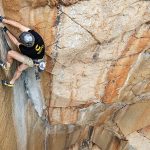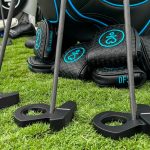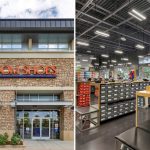Big 5 Sporting Goods (Nasdaq:BGFV) said first-quarter earnings came in at the low end of guidance and issued a weak outlook for the second quarter. The West Coast retailer blamed lackluster spring sales despite the arrival of warmer weather as well as a hyper-promotional climate tied to the troubles at Sports Authority and Sport Chalet.
Big 5 reported a loss in the quarter of $1.1 million, or 5 cents, a share, against earnings of $2.3 million, or 11 cents a share. When reporting fourth-quarter earnings in February, the company projected results in the range of a loss of 5 cents a share to earnings of 2 cents due to signs of increased clearance activity.
Sales in the latest quarter slid 3.7 percent to $234.5 million. A calendar shift that caused its 2016 calendar year to begin one week later than fiscal 2015 as well as the later Easter negatively impacted sales by approximately $3.9 million. Big 5 said a low-single-digit increase in average sales was offset by a low-single-digit decrease in customer transactions. Same-store sales sagged 1.9 percent on a comparable 13-week basis. Same -tore sales were projected to arrive in the negative low single-digit to positive low-single-digit range.
On May 4, the day following the earnings release, shares of Big 5 fell 21.7 percent to $9.50.
On a conference call with analysts, Big 5 President and CEO Steve Miller said the first quarter started off strongly with January comps ahead in the high-single-digit range as the retailer benefited from “extremely favorable” winter weather conditions out west.
However, sales softened significantly mid-quarter, when the weather in mid-February turned warm “and we did not receive the lift in our non-winter-product categories that we might have anticipated.” Comps were down mid-single digits in February and March.
He further said the performance in the last two months of the quarter reflected a challenging retail environment, in particular in the sporting goods sector in connection with liquidation and promotional efforts associated the struggles and bankruptcies of Sports Authority and Sport Chalet.
From a category standpoint, apparel comped positively, in the high-single-digit range for the period, largely on the strength of winter-apparel sales in the first half of the quarter. Footwear sales comped up in the low-single-digit range, and hardgoods comped down in the high-single digits.
The bottom line also reflected a 120 basis-point decline in gross margins to 30.3 percent. Merchandise margins decreased 86 basis points due to the impact of the calendar shift, as well as heightened promotional activity to drive traffic in the challenging environment.
SG&A expense was 30.4 percent sales in the quarter, up from 29.8 percent, as a result of lower sales. On an absolute basis, SG&A expense decreased $1.3 million year over year, primarily reflecting legal-settlement and proxy-contest costs in 2015.
Looking ahead, Miller said sales for the second quarter have remained soft due to ongoing competitors’ liquidation sales from Sports Authority and Sport Chalet. Comps were running down in the low-to-mid-single-digit range.
With April being a low-volume period for the retailer, success in the quarter heavily depends over the back half of the period, which includes Memorial Day, Father’s Day, and the lead up to the Fourth of July, he noted.
For the second quarter, comps are expected in the negative low-single-digit-to-flat range with EPS between break-even and 6 cents a share. Net sales comparisons are expected to benefit from by $7 million as a result of the year’s calendar shift with the pre-Fourth of July holiday sales shifting to the second quarter from third quarter last year.
Regarding the bankruptcies, Miller said about 210 Sports Authority and Sport Chalet stores overlap with about 250 Big 5 stores, or nearly 60 percent of the chain.
Asked how Big 5 can combat the liquidation sales, Miller admitted that “you truly can’t combat a peer going-out-of-business sale.” He noted that stores liquidating will eventually run out of basic products and both bankrupt chains haven’t been receiving fresh inventory.
“We may step up our promotional activity, but we’re certainly going to operate rationally, looking to balance sales and margin, expense control and inventory management, to really ensure that we’re best positioned to benefit from the competitive rationalization, once this effectively is done and over.”
Looking further ahead, Miller that even with additional closings coming from Sports Authority in the weeks ahead, the liquidations should be largely done before the back-to-school selling period.
“Although we certainly do not know at this time what the ultimate outcome will be for all of the Sports Authority and Sport Chalet store locations, we believe that our stores stand to benefit once the competitive landscape rationalizes,” said Miller. “Fortunately, our healthy financial condition offers us the flexibility to take advantage of this opportunity.”
Miller said the company is actively working with the vendor community on opportunistic buys, as well as preparing for potentially increased consumer demand as stores shutter. He added, “If you think about the vendor community, they need to replace the lost business. That promotes a positive conversation in some cases.”
He further said Big 5 is developing market initiatives aimed at introducing Big 5 to consumers “who may soon need a new place to shop for sporting goods.”
Miller didn’t expect to gain any real estate from any leases that may become available. Big 5’s stores average around 11,000 square feet while both the size of Sports Authority and Sport Chalet’s locations run 40,000 square feet or larger.
Miller noted Big 5 continues to maintain a “very healthy balance sheet” that will help the chain weather the industry’s challenges.
Miller added, “While our results may be challenged in the near term, we believe that as conditions in the sporting goods space normalize, our proven business model, which focuses on providing customers with the optimal mix of value, selection, service, and convenience, will enable us to resume positive sales growth and create value for our shareholders.”
–Tom Ryan














